In this article, we will delve into the key challenges of software testing and explore strategies to overcome them successfully. Software testing plays a crucial role in ensuring the quality and reliability of software products. It involves the systematic evaluation of a software system to identify defects, errors, and potential issues. However, the field of software testing faces several challenges that can impact the effectiveness and efficiency of the testing process.
Challenges of Software Testing

Software testing is an integral part of the software development life cycle (SDLC) and aims to identify defects and ensure that software functions as intended. However, software testing faces various challenges that testers must overcome to deliver high-quality software products.
1. Lack of Test Coverage
Achieving comprehensive test coverage is a significant challenge in software testing. Test coverage refers to the extent to which the software's functionalities and use cases are tested. With complex systems and limited resources, it becomes difficult to cover every possible scenario. Testers must prioritize critical functionalities and focus their testing efforts accordingly.
2. Time and Resource Constraints
Testing is often subject to tight schedules and limited resources. Project deadlines may require testers to rush through the testing process, compromising thoroughness and accuracy. Additionally, acquiring skilled testers, suitable testing tools, and adequate testing environments can be challenging, especially in large-scale projects.
3. Complex System Interactions
Modern software systems often interact with multiple components, modules, and external systems. Testing the interactions and dependencies between these elements can be complex and time-consuming. Testers must plan meticulously, coordinate effectively, and implement comprehensive testing strategies to ensure that all integration points are adequately tested.
4. Changing Requirements
Software development is an iterative process, and requirements often evolve throughout the project lifecycle. Changes in requirements pose significant challenges for software testers. They must adapt their test plans and strategies accordingly, ensuring that both new and existing functionalities are thoroughly tested to maintain the overall quality of the software.
5. Testing Environments and Configurations
Creating and managing testing environments that closely resemble the production environment can be demanding. Testers must ensure that the software is tested under realistic conditions, including different operating systems, hardware configurations, and network setups. Setting up and maintaining these environments require specialized knowledge and resources.
6. Data Management
Software testing often involves the generation and management of large volumes of test data. Testers must ensure the availability of relevant and realistic test data to simulate various scenarios. Effective management of test data, including data generation, anonymization, and storage, presents a significant challenge.
7. Test Case Prioritization
With limited time and resources, prioritizing test cases becomes crucial. Testers must identify and prioritize high-risk areas and critical functionalities to focus their testing efforts effectively. Making informed decisions about test case prioritization requires a deep understanding of the software system and its potential vulnerabilities.
8. Communication and Collaboration
Effective communication and collaboration among the development team, testers, and other stakeholders are vital for successful software testing. Poor communication can lead to misunderstandings, delays, and even defects slipping through the testing process. Ensuring clear communication channels and fostering a collaborative environment is essential for overcoming this challenge.
Conclusion On Challenges of Software Testing
Software testing is a complex and challenging process, but with the right approach and strategies, these challenges can be overcome. By addressing the lack of test coverage, managing time and resources effectively, handling complex system interactions, adapting to changing requirements, ensuring realistic testing environments, managing test data efficiently, prioritizing test cases wisely, fostering communication and collaboration, acquiring necessary technical skills, leveraging test automation, performing thorough regression testing, conducting robust security testing, and implementing reliable performance testing, software testing teams can achieve higher levels of quality and deliver software products that meet user expectations.
Revolutionize your software testing with Robonito, the ultimate no-code RPA automation testing tool. Say goodbye to endless testing hours – Robonito slashes testing time by a staggering 98%! Ready to experience the future of software testing? BOOK A FREE DEMO NOW and transform your testing process today!
FAQs On Challenges of Software Testing
1. How can I ensure comprehensive test coverage?
To achieve comprehensive test coverage, prioritize critical functionalities, perform risk analysis, and focus on high-risk areas. Utilize techniques such as equivalence partitioning and boundary value analysis to cover a wide range of scenarios.
2. What are the key considerations in selecting a testing tool?
When selecting a testing tool, consider factors such as the project requirements, compatibility with the software under test, ease of use, scalability, and support for automation and integration.
3. How can I effectively manage test data?
Ensure the availability of relevant and realistic test data by generating representative datasets. Use data anonymization techniques to protect sensitive information. Implement data management tools and frameworks for efficient storage and retrieval.
4. What are the benefits of test automation?
Test automation offers advantages such as increased efficiency, repeatability, and broader test coverage. It helps save time and effort, improves test accuracy, and allows for quicker feedback on software quality.
5. How often should regression testing be performed?
Regression testing should be performed whenever changes are made to the software, such as bug fixes, enhancements, or new feature additions. It is crucial to ensure that existing functionalities are not adversely affected.
